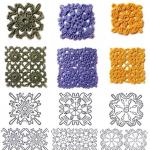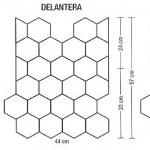Hands in fists in newborns. Third month: the best toy is your own hands
“So, I'm a mom. So what now?..” - many women face this feeling of confusion when they have their first child. “I look at my baby and understand that I have no idea what to do now, which way to approach her,” mothers’ stories are like carbon copies. Then it becomes relatively clear what to do: feed, bathe, change the diaper. But what the child wants at this particular moment - this usually remains a sealed secret until he learns to speak or at least gesticulate. We've got seven key ways to tell what your baby is trying to say with body language.
1. Kicks his legs
If a baby kicks space, that's great. In his body language, this means he is happy and having a great time. Kicks are your baby's way of expressing pleasure. Please note that children often begin to kick their legs when you play with them or during water procedures. And if at this time you take the baby in your arms and sing him a song, he will become even happier.
Photo GettyImages
2. Arches the back
This is usually a reaction to pain or discomfort. Children often arch their backs when they have colic or heartburn. If your baby arches while you feed him, this could be a sign of reflux. Try to avoid stress while breastfeeding - the mother’s worries affect the baby.
3. Shakes his head
Sometimes babies can jerk their heads sharply, hitting the bottom of the crib or its sides. This is again a sign of discomfort or pain. Rocking motion usually helps, but if the child continues to shake his head, this is a reason to take the baby to the pediatrician.
4. Grabs his ears
Don't immediately panic if your baby pulls his ears. In this way he has fun and learns - the surrounding sounds become quieter, then louder again. In addition, babies often grab their ears when they are teething. But if the child cries, you need to run to the doctor and check whether the child has caught an ear infection.
5. Clenches his fists
In general, this is one of the first meaningful body movements that a newborn masters. Additionally, a clenched fist can be a sign of hunger or stress, both of which cause your baby's muscles to tense up. If the child continues to have the habit of clenching his fists tightly when he is more than three months old, it is better to show the baby to the doctor. This may be a sign of a neurological disorder.
Photo GettyImages
6. Twists, bringing knees to chest
This movement is most often a sign of digestive problems. Maybe it's colic, maybe it's constipation or gas. If you are breastfeeding, watch your diet: something in the diet causes increased gas formation. And do not forget to hold the baby upright after feeding so that he burps the air. If constipated, consult your doctor.
7. Throws up his arms
This is the child's first reaction to environment, a sign of caution. As a rule, the baby throws up his arms when he hears a sudden sound or when a bright light turns on. Sometimes babies do this when you put them in their crib: they feel a loss of support. This reflex usually disappears four months after birth. Until then, it is worth remembering that the movement is unconscious, and the child may accidentally scratch himself. Therefore, children are advised to swaddle or put special mittens on their hands while they sleep.
The sooner the baby opens his fists, the sooner he will begin to play with his hands. If the child still keeps his fists clenched all the time, try to help him. Gently tap on the back of them to stimulate the reflex that causes the baby to unclench his fingers.
Quite recently, not so long ago, you were playing with small hands, unclenching your tightly clenched fingers and running your baby’s palms over your cheeks. Now he has learned to play with his own hands.
This is the most remarkable feature of the 3rd month of development. The previously clenched fists unclench and the fingers remain half-open.
At this time, babies try to reach with their hands the most familiar and easily accessible toys and, what is even more important, themselves. Watch how the baby plays with his own hands. He can grab one hand with the other and hold in his palm from time to time a whole fist, and from time to time 1-2 fingers. It goes without saying that these interesting little hands find their way to the mouth; Thumb sucking is a favorite pastime at this age.
Reach and grab. Watches, hair, clothes - everything becomes a desired goal for these little hands. A baby at this age loves to grab his hair, grab his glasses, his father’s tie, and most willingly, his mother’s blouse, when she takes him in her arms. These first grasping movements are very strong and far from gentle. If your hair is caught in a child's fist, it is not so easy to get it out.
These movements are not yet very definite. While the baby tries to reach out and grab the suspended toy, he usually does not achieve the goal. The movements of his hands remain shortened, similar to the sharp blows of a boxer or karateka. But in a month things will get better, the blows will hit the target.
Holding power. The baby's hand becomes stronger. Having grabbed an object, he holds it, instead of immediately dropping it, as before. The baby squeezes the rattle placed in his hand with his fingers, holds it and studies it until he gets tired or gets tired of it. Which rattle should you choose?
- The lighter the rattle and the easier it is to hold, the longer the child will engage with it.
— Dark and white, and contrasting colors attract the baby’s attention more.
— Babies prefer soft ones made of fabric to plastic rattles.
- The most reliable rattle is one that will not cause any harm - at least 1.5-2 inches (up to 5 cm), without sharp corners or protruding parts.
The best position for playing with your own hands

The child's position significantly influences the development of hand motor skills. The horizontal position interferes with play with the handles, while the vertical position facilitates it. Lying on a flat, smooth surface (for example, on the floor), the child creates movements in free style- something like a bicycle, made with both arms and legs; he can stretch his limbs in different directions. But while the baby at this age is lying on his back, the still active reflex of the resting neck is triggered (when the head is turned in the same direction, the handle reclines, and the fists remain clenched). It is much better if you hold the child in a semi-upright position on your lap or put him in a special baby chair. In this position his head is turned forward and he looks straight ahead; At the same time, his fists unclench and he stretches his arms towards you, as if for a hug. Thus, a semi-vertical position encourages the child to start playing with his hands or to engage in some kind of toy, holding it in front of him.
Watch your baby while he becomes interested in the pattern on the wallpaper or closely studies your face. Now he can do this for much longer and pays more attention to details instead of just staring at them.
He follows you better with his eyes as you pass by, and at the same time, like a radar, he turns his head. If you leave the room, he may start crying.
At this stage of development, children see not only better, but also further. Once in a state of concentrated composure, the child can look at the ceiling and the fan on it, black contrasting railings, shadows on the walls, plants located at a distance of 15-20 feet (5-6 m) from him. Black contrasting objects against a bright background remain the most attractive.
From Martha's journal: I manage to attract Matthew's interest by using a black and white 6-sided cube, about 2 inches in size, which I place in front of his eyes. For a while he is simply transfixed by these moving pictures and studies each side as the cube slowly rotates. It is also thought that it distinguishes images on each face. From time to time, if Matthew starts to act up, I remove the cube and the moodiness stops.

Conversation with a 3-month-old baby
Now is when the real conversations begin. This period seems easier to you than the previous ones, because this moment you have the opportunity to become aware of your baby. Observe his body movements and facial expressions, try to figure out what he is thinking about while he behaves in one way or another. By understanding his body language and facial expressions, you can predict what will follow: is he planning to start crying or smiling? With timely intervention in the situation (Hey. (name)!), you can turn the impending crying into a smile. Your happy face can make your baby forget that he wanted to start crying.
Various shapes crying. Now it is not only easier for you to read the baby’s body language, but also the reason for his crying becomes more intelligible. Different cries reflect different baby needs. Demanding crying and a face flushed from tension are a sign of an urgent desire to be in your arms. With whining crying, it is possible to limit yourself to answering from a long distance, even from another room. Pay attention to the pauses that punctuate the baby's crying. It is as if he informs you that he is expecting an answer, and without taking it, he continues to call you.
Expanding vocabulary. The child begins to say more - the sounds he makes become louder and longer. He begins to drag out vowel sounds for a long time (aaah, uh, uh, oooh). Listen to this continuous humming, cooing, grunting, sniffling, squealing and sighing. It seems that the baby is trying out what other sounds can be produced through his mouth and tongue. The child is interested in how loudly he can squeal, and especially how such screams affect you. And I think he will soon begin to realize that these kinds of sounds create a shock impression on his parents. All this does not mean that he does not like pleasant sounds. In addition, at this early stage of development, the child tries to adapt the sound of his own speech to yours. If you meet your child's ear-piercing scream with a soft whisper, perhaps he will moderate his volume.

Movements of a 3 month old baby
Place the baby on a soft surface on the table. Position yourself so that your head is at the same level. Try to make eye contact and start talking. The child can raise his head 45 degrees or more and continue this conversation head to head. Now his head does not fall helplessly down as before; he can hold her in this position for some time. Turning his head from side to side, he begins to study the world.
A new game. Turn the child onto his back (most children at this age will not yet be able to roll over on their own), holding him with both hands, slowly move him to a sitting position. The head and torso will rise at the same time, whereas in previous weeks the head movements were lagging. In a sitting position, the baby's head does not sway as before, but becomes stable. It goes without saying that if the head is not helped and supported, the head will quickly bow, but the child can return it to a controlled upright position.
Stand and support. Take the baby under the arms and hold him in a standing position. A month ago, his legs immediately gave way. Now they are within a few minutes. carry the load of the whole body and your support is needed only to maintain balance. Now put the baby in your arms, leaning him against your chest. Do you notice how stronger his legs have become?
Game on the floor. The game of up and down has begun. Most 3-month-old babies love being held in your arms, but they may enjoy lying on the floor and enjoying freedom of movement. The restraining reflex of the resting neck slowly begins to weaken, allowing the baby to stretch his arms and legs in different directions and make movements like a bicycle (from time to time this is called flapping his wings). Naturally, such exercises are encouraged by admiring spectators from above. But it will be better if you sit down next to the baby on the floor and keep him company.
Circumstance and consequence. At 3 months, the child discovers that he can somehow influence the world around him. I pull a hanging toy - it moves, I shake a rattle - it rattles. Thus he discovers the connection between effect and cause. This discovery is stored in his developing brain, and he begins to use it in order to get the desired result. For example, by this time the baby learns to suck more effectively - so as to get more milk at less cost
From Martha's diary: I saw that Matthew was catching my breast, making a couple of sucking movements, and then waiting for the milk eruption reflex to work and it to flow into his mouth in a full stream. Only then does he begin to actively suck and swallow. He realized that this was the easiest method to start feeding.
A woman who recently became a mother monitors the health of her baby very carefully and reverently. But often a newborn does not behave as described in books. There are signs that a mother should immediately sound the alarm when she sees them. But there are also completely harmless physiological ones that disappear in the first year of life. Today we will talk about muscle tone in infants. Let's try to understand what it is and how to deal with the problem.
Muscle tone - what is it?
Muscle tone in newborns is a phenomenon that is becoming more and more common, but why does it occur?
The fact is that in the mother’s belly, the baby’s first home, the space is very limited. The baby is growing, developing and it is becoming increasingly cramped in his home; he can no longer move his arms and legs normally.
Remember the “fetal position”: the baby’s arms are crossed on the chest, legs bent at the knees.
A long stay in this state cannot but affect the muscles, which are constantly very tense. That is, a phenomenon such as tone occurs due to increased muscle resistance, which appears during passive stretching during movement in the joint.
Increased muscle tone in babies can persist for some time after birth; this phenomenon should completely disappear by 1 year. A decrease in tone occurs already by 3-4 months.
Diagnosing the problem
Immediately after birth, of course, not in the first minutes, but still in maternity hospital, infants are beginning to be diagnosed for muscle tone.
After discharge, the baby will undergo a monthly examination; at the appointment, the doctor will also pay attention to tone, especially the first three months. In babies born "on one's own", and during the period of gestation and labor, located in the tummy according to all physiological rules, the positioning of the limbs and the resistance of the muscles, or rather, their individual groups, allows during the examination to determine whether the tone corresponds to the norm or not.
Babies born with help caesarean section or were for a long time in the mother's stomach in pelvic position, they may have a different body position after birth. That is why the pediatrician or neurologist conducting the examination will ask about the course of pregnancy and the birth itself.
If you see the inscription on your baby’s card “Tone is dystonic”, no need to sound the alarm, just figure out what’s what. So what is dystonic muscle tone? This is a syndrome in which the baby’s motor activity is impaired and there is improper muscle development. Most often, this problem is diagnosed in infancy and, by the way, the earlier it is detected, the easier and more effectively it can be dealt with.
Observing the baby: identifying the problem
To notice the problem as early as possible, experts recommend that young mothers closely monitor their children and evaluate them motor activity depending on age.
From birth to one month old your “sun” can maintain its usual fetal position. If a baby presses his arms to his chest, this indicates normal muscle development. Doctors advise observing how the newborn clenches his fists. With normal development, the thumb should be inside when clenching a fist.
If you put the baby on his tummy, he should make bending movements with his legs, as if he wants to crawl. To the baby’s first “anniversary” – 1 month, he will already try to raise and hold his head, in time it will only be a couple of seconds, everything happens at the reflex level and is considered the norm for all children of this age.
The next period of muscle development will be 1-3 months of life. By this time, tension in the muscles begins to subside, the baby begins to have more conscious movements and reactions: he begins to reach for a toy, and by the end of the third month, he begins to hold light objects in his hand. There is a reaction (rotation of the head) to the source of light and sound. By the end of this period, the baby can already hold his head up. By placing your baby on his back and lightly pulling his arms, you will see that he is trying to pull himself up using his own strength. Holding your child in an upright position and standing on his feet, the baby will try to walk. At the age of three months, the child should rest on his full foot.
From 3 to 6 months the baby will improve his skills: He will begin to confidently hold the rattle in his hands, and will be interested not only in objects located exactly in front of him, but also around him. During these months, your son or daughter will learn to roll over onto his tummy and back onto his back, and will also try to get up on all fours.
Between 6 months and 1 year there will be two more major leaps in muscle development: at 6-9 months and at 9-12. During this period of time, the little one will learn to sit and stand up independently, first with the help of support, and only then without it. Many children begin to walk slowly by one year. Development is happening fine motor skills: new grasping movements appear. Now the child is increasingly picking up objects, using his thumb and forefinger.
If you notice that your baby is developing somehow differently and does not have certain skills that he should have, then you should consult a doctor. Unfortunately, in Lately More and more newborns are born with impaired muscle tone. This problem can be caused by a huge number of factors, for example, hereditary illnesses of the mother, poor nutrition during pregnancy, etc.
Hypertonicity in newborns. Up to three to four months of life, increased muscle tone in newborns is the norm, so mothers should not be bothered by the fact that the baby cannot be grasped by the fingers due to tightly clenched fists.
All newborns up to a certain age arrive in the Buddha pose (arms pressed to the chest, legs tucked to the tummy), the reason for this is the increased tone of the flexor muscles in the legs and arms of the newborn. By the age of three months, the baby should already begin to unclench and clench his fists and try to grasp the toy with his fingers. If at this age the child still keeps his fists tightly clenched, it is necessary to contact a neurologist who will prescribe massage, gymnastics or swimming for the baby. With the help of these procedures this problem will be resolved.

Some signs in newborns that should not be alarmed:
— Many young mothers are afraid of the bluish tint of the newborn’s fists and feet, which can be seen if you look closely. There is no need to worry about this, since this is due to the fact that the baby’s blood circulation has not yet improved. Take a closer look, because as soon as the baby moves his arms and legs more actively, his feet and fists immediately turn pink.
— Some newborn babies have feet that are strongly turned inward or outward, this is due to weakness of the muscles in the ankle joint, which is caused by hypoxia (lack of oxygen) during pregnancy. There is no need to worry about this either, since such defects are corrected with massage.
— Young mothers are very frightened when they discover that their newborn baby is secreting milk from swollen nipples. There is no reason to be afraid; in fact, this is a completely normal phenomenon for newborns, both for girls and boys. This phenomenon is called a hormonal crisis of a newborn.
A newborn's hormonal crisis is caused by maternal hormones entering the baby's blood. This phenomenon goes away on its own. Under no circumstances should milk be squeezed out of a baby’s nipples! Milky discharge may appear on the third to fifth day after birth, last a week, and then disappear.
- Some newborn boys do not have testicles in their natural place, this is due to the fact that the testicle does not have time to descend into the groin before birth. Mothers should not worry until they are one year old; often the testicles descend on their own; if the situation has not changed until one year, the testicles are removed surgically.
— There are situations when newborn boys’ testicles, on the contrary, are too large and swollen, this is caused by swelling of the testicular membrane. This cannot be treated, but goes away on its own, but the newborn should be under the supervision of a surgeon.
— As for newborn girls, real panic in young mothers can be caused by the appearance bloody discharge girls. There is no need to panic, because there is nothing terrible in this, this is also a hormonal crisis that will not last long.
“My three-month-old baby is so friendly,” exclaims one mother. “She seems so responsive to me,” says another. “I just melt when he reaches out to me with his little hands,” adds a third.
The third month is an exciting period for both the baby and the parents. Your child becomes more animated, active, organized and responsive. Communication with him takes place at a qualitatively new level, because by the 3rd month both the child and the parents begin to understand each other’s signals. It is these reasons that allow parents to characterize the third month as the easiest.
Open baby's fists
The sooner the baby opens his fists, the sooner he will begin to play with his hands. If your child still keeps his fists clenched all the time, try helping him. Gently tap on the back of them to stimulate the reflex that causes the baby to open his fingers.
Entertaining hands
Just recently you were playing with little hands, unclenching your tightly clenched fingers and running your baby’s palms over your cheeks. Now he has learned to play with his own hands.
This is the most remarkable feature of the 3rd month of development. The previously clenched fists unclench and the fingers remain half-open.
During this period, babies try to reach with their hands the most familiar and easily accessible toys and, more importantly, themselves. Watch your baby play with his own hands. He can grab one hand with the other and sometimes hold the entire fist in his palm, and sometimes 1-2 fingers. Of course, these curious little hands find their way to the mouth; Thumb sucking is a favorite pastime at this age.
Reach and grab. Watches, hair, clothes - everything becomes a desired target for these little hands. A baby at this age loves to grab his hair, grab his glasses, his father’s tie, and most willingly, his mother’s blouse when she takes him in her arms. These first grasping movements are very strong and far from affectionate. If your hair is caught in a child's fist, it is not so easy to get it out.
These movements are not yet very defined. When a baby tries to reach out and grab a dangling toy, he often fails to achieve his goal. The movements of his hands remain shortened, similar to the sharp blows of a boxer or karateka. But in a month things will get better, the blows will hit the target.
Holding power. The baby's hand becomes stronger. Having grabbed an object, he holds it, instead of immediately dropping it, as before. The baby squeezes the rattle placed in his hand with his fingers, holds it and studies it until he gets tired or gets tired of it.
Which rattle should you choose?
- The lighter the rattle and the easier it is to hold, the longer the child will engage with it.
- Black and white, as well as contrasting colors, attract the baby's attention more.
- Babies prefer soft ones made of fabric to plastic rattles.
- The safest rattle is one that will not cause any harm - at least 1.5-2 inches (up to 5 cm), without sharp corners or protruding parts.
The best position for playing with your own hands
The child's position significantly influences the development of hand motor skills. The horizontal position prevents play with the handles, the vertical position promotes it. Lying on a flat, smooth surface (for example, on the floor), the child makes movements in a free style - something like a “bicycle”, performed simultaneously with both arms and legs; he can stretch his limbs in different directions. But when a baby at this age lies on his back, the still active reflex of the resting neck is triggered (when the head is turned in the same direction, the handle reclines, and the fists remain clenched). It is much better if you hold the child in a semi-upright position on your lap or put him in a special baby chair. In this position, his head is turned forward and he looks straight ahead; at the same time, his fists unclench and he, as if for a hug, pulls his hands towards you. Thus, the semi-upright position encourages the child to start playing with his hands or engage in some kind of toy, holding it in front of him.






